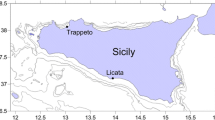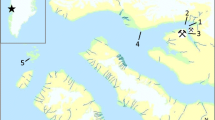Abstract
The content of 53 micro- and ultramicroelements in otoliths of two deep-sea fish species, blue antimora Antimora rostrata from the Northwest Atlantic (NWA) and Pacific flatnose Antimora microlepis from the Northeast Pacific (NEP), is studied. The otoliths of these species were characterized by the maximum concentration of strontium, nickel, zinc, barium, chromium, copper, lithium, cobalt, and zirconium (in descending order). The content of barium, tungsten, and lithium was higher in otoliths of the former species, while that of yttrium and uranium, in otoliths of the latter. This is probably due to differences in the chemical composition of NWA and NEP waters, as well as to differences in the linear size of fishes and changes in the concentrations of individual elements during ontogeny. The lead, arsenic, zinc, copper, and nickel contents in the otoliths, kidneys, muscles, and liver of fishes from different areas are compared.
Similar content being viewed by others
REFERENCES
T. A. Davletshina, L. V. Shul’gina, K. G. Pavel’, and I. V. Mal’tsev, “Technoeconomic characteristics of abyssal fish finescale mora Antimora microlepis,” Izv. Tikhookean. Nauchno-Issled. Inst. Rybn. Khoz. Okeanogr. 198, 230–238 (2019).
A. M. Orlov, R. V. Artemov, and S. Yu. Orlova, “The elemental composition of swimbladders in some deepwater fishes of the North Atlantic,” Russ. J. Mar. Biol. 42, 495–500 (2016).
D. S. Pavlov, K. V. Kuzishchin, M. A. Gruzdeva, et al., “Life history strategy diversity in the Kamchatkan Dolly Varden char Salvelinus malma (Walbaum) (Salmonidae, Salmoniformes): ontogenetic reconstructions based on the data of X-ray fluorescence analysis of the microchemistry of recording structures,” Dokl. Biol. Sci. 450, 142–145 (2013).
D. S. Pavlov, K. Yu. Samoilov, K. V. Kuzishchin, et al., “Diversity of life strategies of pikepech Sander lucioperca (L.) in the Lower Volga (by the data of microelement composition of otoliths),” Inland Water Biol. 9, 382–389 (2016).
L. A. Pavlova and S. M. Pavlov, “X-ray spectral electron-probe microanalysis of fish otoliths as an advanced method for environmental monitoring,” Metody Ob”ekty Khim. Anal. 1 (1), 48–53 (2006).
J. R. Ashford, A. I. Arkhipkin, and C. M. Jones, “Can the chemistry of otolith nuclei determine population structure of Patagonian toothfish Dissostichus eleginoides?” J. Fish. Biol. 69, 708–721 (2006).
G. E. Bath, S. R. Thorrold, C. M. Jones, et al., “Strontium and barium uptake in aragonitic otoliths of marine fish,” Geochim. Cosmochim. Acta 64 (10), 1705–1714 (2000).
G. A. Begg, S. E. Campana, A. J. Fowler, and I. M. Suthers, “Otolith research and application: current directionsin innovation and implementation,” Mar. Freshwater Res. 56, 477–483 (2005).
G. M. Cailliet, A. H. Andrews, E. J. Burton, et al., “Age determination and validation studies of marine fishes: do deep-dwellers live longer?” Exp. Gerontol. 36 (4–6), 739–764 (2001).
S. E. Campana, “Chemistry and composition of fish otoliths: pathways, mechanisms and applications,” Mar. Ecol.: Prog. Ser. 188, 263–297 (1999).
S. E. Campana, “Otolith elemental composition as a natural marker of fish stocks,” in Stock Identification Methods, Ed. by S. X. Cadrin, (Academic, New York, 2005), pp. 227–245.
S. E. Campana and S. R. Thorrold, “Otoliths, increments, and elements: keys to a comprehensive understanding of fish populations?” Can. J. Fish. Aquat. Sci. 58 (1), 30–38 (2001).
M. Cronin, I. M. Davies, A. Newton, et al., “Trace metal concentrations in deep sea fish from the North Atlantic,” Mar. Environ. Res. 45, 225–238 (1998).
F. A. Cross, L. H. Hardy, N. Y. Jones, and R. T. Barber, “Relation between total body weight and concentrations of manganese, iron, copper, zinc, and mercury in white muscle of bluefish (Pomatomus saltatrix) and a bathy-demersal fish (Antimora rostrata),” J. Fish. Res. Board Can. 30, 1287–1291 (1973).
G. E. Fenton and S. A. Short, “Radiometric analysis of blue grenadier, Macrunonus novaezelandiae, otolith cores,” Fish. Bull. 93 (2), 391–396 (1995).
P. H. Frey, A. A. Keller, and V. Simon, “Dynamic population trends observed in the deep-living Pacific flatnose, Antimora microlepis, on the U.S. West coast,” Deep Sea Res., Part I 122, 105–112 (2017).
I. Gordeev, S. Sokolov, R. Bañon, et al., “Parasites of the blue antimora, Antimora rostrata and slender codling, Halargyreus johnsonii (Gadiformes: Moridae), in the Northwestern Atlantic,” Acta Parasitol. 64 (3), 489–500 (2019).
R. Higgins, E. Isidro, G. Menezes, and A. T. Correia, “Otolith elemental signatures indicate population separation in deep-sea rockfish, Helicolenus dactylopterus and Pontinus kuhlii, from the Azores,” J. Sea Res. 83, 202–208 (2013).
G. R. Hoff and L. A. Fuiman, “Environmentally-induced variation in elemental composition of red drum (Sciaenops ocellatus) otoliths,” Bull. Mar. Sci. 56, 578–591 (1995).
C. R. Kastelle, D. K. Kimura, A. E. Nevissi, and D. R. Gunderson, “Using Pb-210/Ra-226 disequilibria for sablefish, Anoplopoma fimbria, age validation,” Fish. Bull. 92 (2), 292–301 (1994).
M. Labonne, E. Morize, M. Kulbicki, et al., “Otolith chemical signature and growth of Chaetodon speculum in coastal areas of New Caledonia,” Estuarine, Coastal Shelf Sci. 78 (3), 493–504 (2008).
C. Longmore, K. Fogarty, F. C. Neat, et al., “A comparison of otolith microchemistry and otolith shape analysis for the study of spatial variation in a deep-sea teleost, Coryphaenoides rupestris,” Environ. Biol. Fish. 89, 591–605 (2010).
C. Longmore, C. Trueman, F. Neat, et al., “Otolith geochemistry indicates life-long spatial population structuring in a deep-sea fish, Coryphaenoides rupestris,” Mar. Ecol.: Prog. Ser. 435, 209–224 (2011).
C. Longmore, C. N. Trueman, F. Neat, et al., “Ocean-scale connectivity and life cycle reconstruction in a deep-sea fish,” Can. J. Fish. Aquat. Sci. 71 (9), 1312–1323 (2014). https://doi.org/10.1139/cjfas-2013-0343
I. Martins, V. Costa, F. M. Porteiro, et al., “Mercury concentrations in fish species caught at Mid-Atlantic Ridge hydrothermal vent fields,” Mar. Ecol.: Prog. Ser. 320, 253–258 (2006).
S. Mormede and I. M. Davies, “Heavy metal concentrations in commercial deep sea fish from the Rockall Trough,” Cont. Shelf Res. 21 (8–10), 899–916 (2001).
R. L. Radtke and D. J. Shafer, “Environmental sensitivity of fish otolith microchemistry,” Mar. Freshwater Res. 43 (5), 935–951 (1992).
J. N. Smith, R. Nelson, and S. E. Campana, “The use of Pb-210/Ra-226 and Th-228/Ra-228 dis-equilibria in the ageing of otoliths of marine fish,” in Radionuclides in the Study of Marine Processes, Ed. by P. J. Kershaw and D. S. Woodhead (Springer-Verlag, New York, 1991), pp. 350–359.
S. C. Swan, J. D. M. Gordon, and T. Shimmield, “Preliminary investigations on the uses of otolith microchemistry for stock discrimination of the deep-water black scabbardfish (Aphanopus carbo) in the North East Atlantic,” J. Northwest Atl. Fish. Sci. 31, 221–231 (2003).
S. C. Swan, J. D. M. Gordon, B. Morales-Nin, et al., “Otolith microchemistry of Nezumia aequalis (Pisces: Macrouridae) from widely different habitats in the Atlantic and Mediterranean,” J. Mar. Biol. Assoc. U.K. 83, 883–886 (2003).
P. Vas, J. D. M. Gordon, P. R. Fielden, and J. Overnell, “The trace metal ecology of the ichthyofauna in the Rockall Trough, North-Eastern Atlantic,” Mar. Pollut. Bull. 26 (11), 607–612 (1993).
B. Walther and S. R. Thorrold, “Water, not food, contributes the majority of strontium and barium deposited in the otoliths of a marine fish,” Mar. Ecol.: Prog. Ser. 311, 125–130 (2006).
ACKNOWLEDGMENTS
The authors are grateful to their colleagues Rafael Bañon (Instituto de Investigations Marinas, Vigo, Spain) and Peter Frey (Northwest Fisheries Science Center, Seattle, United States) for providing Antimora spp. otoliths, as well as to L.A. Pel’gunova (Institute of Ecology and Evolution, Russian Academy of Sciences, Moscow, Russia) for providing valuable advice during preparation of this report.
Author information
Authors and Affiliations
Corresponding author
Additional information
Translated by D. Zabolotny
Rights and permissions
About this article
Cite this article
Korostelev, N.B., Orlov, A.M. Micro- and Ultramicroelemental Content in Otoliths of Blue Antimora Antimora rostrata and Pacific Flatnose A. microlepis (Moridae, Teleostei). Oceanology 60, 798–802 (2020). https://doi.org/10.1134/S0001437020050094
Received:
Revised:
Accepted:
Published:
Issue Date:
DOI: https://doi.org/10.1134/S0001437020050094




